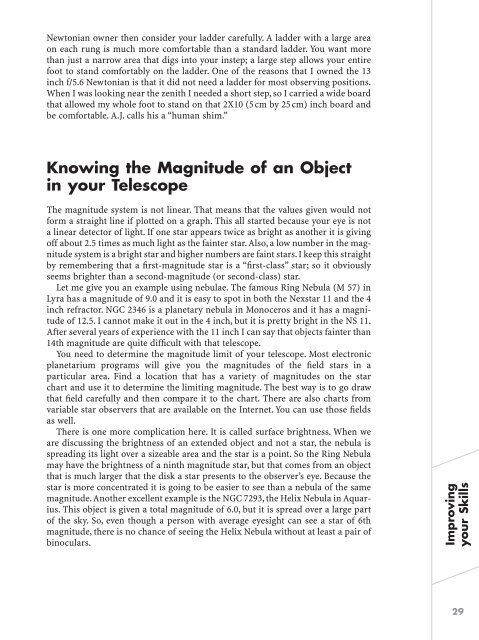Nebulae and How to Observe Them
Nebulae and How to Observe Them
Nebulae and How to Observe Them
Create successful ePaper yourself
Turn your PDF publications into a flip-book with our unique Google optimized e-Paper software.
New<strong>to</strong>nian owner then consider your ladder carefully. A ladder with a large area<br />
on each rung is much more comfortable than a st<strong>and</strong>ard ladder. You want more<br />
than just a narrow area that digs in<strong>to</strong> your instep; a large step allows your entire<br />
foot <strong>to</strong> st<strong>and</strong> comfortably on the ladder. One of the reasons that I owned the 13<br />
inch f/5.6 New<strong>to</strong>nian is that it did not need a ladder for most observing positions.<br />
When I was looking near the zenith I needed a short step, so I carried a wide board<br />
that allowed my whole foot <strong>to</strong> st<strong>and</strong> on that 2X10 (5cm by 25cm) inch board <strong>and</strong><br />
be comfortable. A.J. calls his a “human shim.”<br />
Knowing the Magnitude of an Object<br />
in your Telescope<br />
The magnitude system is not linear. That means that the values given would not<br />
form a straight line if plotted on a graph. This all started because your eye is not<br />
a linear detec<strong>to</strong>r of light. If one star appears twice as bright as another it is giving<br />
off about 2.5 times as much light as the fainter star. Also, a low number in the magnitude<br />
system is a bright star <strong>and</strong> higher numbers are faint stars. I keep this straight<br />
by remembering that a first-magnitude star is a “first-class” star; so it obviously<br />
seems brighter than a second-magnitude (or second-class) star.<br />
Let me give you an example using nebulae. The famous Ring Nebula (M 57) in<br />
Lyra has a magnitude of 9.0 <strong>and</strong> it is easy <strong>to</strong> spot in both the Nexstar 11 <strong>and</strong> the 4<br />
inch refrac<strong>to</strong>r. NGC 2346 is a planetary nebula in Monoceros <strong>and</strong> it has a magnitude<br />
of 12.5. I cannot make it out in the 4 inch, but it is pretty bright in the NS 11.<br />
After several years of experience with the 11 inch I can say that objects fainter than<br />
14th magnitude are quite difficult with that telescope.<br />
You need <strong>to</strong> determine the magnitude limit of your telescope. Most electronic<br />
planetarium programs will give you the magnitudes of the field stars in a<br />
particular area. Find a location that has a variety of magnitudes on the star<br />
chart <strong>and</strong> use it <strong>to</strong> determine the limiting magnitude. The best way is <strong>to</strong> go draw<br />
that field carefully <strong>and</strong> then compare it <strong>to</strong> the chart. There are also charts from<br />
variable star observers that are available on the Internet. You can use those fields<br />
as well.<br />
There is one more complication here. It is called surface brightness. When we<br />
are discussing the brightness of an extended object <strong>and</strong> not a star, the nebula is<br />
spreading its light over a sizeable area <strong>and</strong> the star is a point. So the Ring Nebula<br />
may have the brightness of a ninth magnitude star, but that comes from an object<br />
that is much larger that the disk a star presents <strong>to</strong> the observer’s eye. Because the<br />
star is more concentrated it is going <strong>to</strong> be easier <strong>to</strong> see than a nebula of the same<br />
magnitude.Another excellent example is the NGC 7293, the Helix Nebula in Aquarius.<br />
This object is given a <strong>to</strong>tal magnitude of 6.0, but it is spread over a large part<br />
of the sky. So, even though a person with average eyesight can see a star of 6th<br />
magnitude, there is no chance of seeing the Helix Nebula without at least a pair of<br />
binoculars.<br />
Improving<br />
your Skills<br />
29











